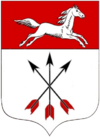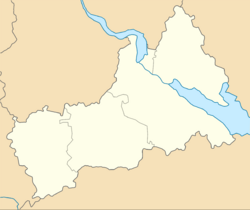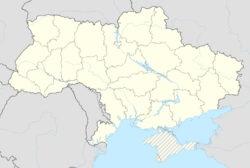Place:Chyhyryn
Chyhyryn Чигирин | |
|---|---|
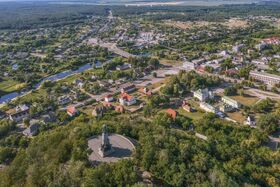 View of Chyhyryn | |
| Coordinates: [ ⚑ ] : 49°04′38″N 32°38′57″E / 49.07722°N 32.64917°E | |
| Country | |
| Oblast | Cherkasy Oblast |
| Raion | Cherkasy Raion |
| Hromada | Chyhyryn urban hromada |
| City rights | 1592 |
| Government | |
| • Mayor | Serhiy Oleksiiovych Tymchenko |
| Area | |
| • Total | 14 km2 (5 sq mi) |
| Elevation | 124 m (407 ft) |
| Population (2022) | |
| • Total | 8,539 |
| • Density | 854/km2 (2,210/sq mi) |
| Postal code | 20900-20906 |
| Area code(s) | +380 4730 |
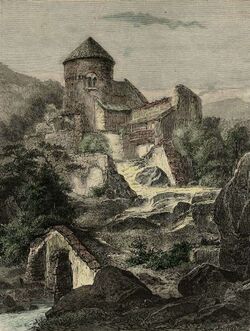
Chyhyryn (Ukrainian: Чигирин, pronounced [tʃɪɦɪˈrɪn]; Polish: Czehryń, pronounced [ˈt͡ʂɛ.xrɨɲ]) is a city in Cherkasy Raion, Cherkasy Oblast, central Ukraine . It is located on Tiasmyn river not far where it enters Dnieper.
From 1648 to 1669, the city served as the residence of the hetman of the Zaporizhian Host. After a forced relocation of the Ruthenian Orthodox metropolitan see from Kyiv in 1658, it became a full-fledged capital of the Cossack Hetmanate. Among Metropolitans who served out of Chyhyryn were family of Tukalsky: Dionysius Balaban-Tukalskyi and Joseph Tukalskyi-Nelyubovych. Chyhyryn also became a traditional place for the appointment to the office of the hetman of the Zaporizhian Host.
Since the 17th century, the significance of the settlement was diminished to a semi-rural populated place. It hosts the administration of Chyhyryn urban hromada (uk), one of the hromadas of Ukraine.[1] Population: Template:Ua-pop-est2022
Names
Chyhyryn (Ukrainian: Чигирин; Turkish: Çigirin or Çehrin; Russian: Чигирин; Polish: Czehryń). On older maps it is often shown in Polish/Turkish-like transcription Czehrin (see Ch (digraph)).
History

I - Central bastion or "bulwark" of the New Castle
II - Bastion ("dungeon") of Doroshenko
III - Bastion with the Crimean Tower
IV - The Spassky Gate with a wooden tower and a double ravelin in front of them
V - Wooden tower on a stone foundation, "New Goat Horn"
VI - Tower and the well
VII - Stone corner bastion
VIII - Stone round tower
IX - The Kyiv Tower with a gate to the bridge
X - Noname tower (just built in 1678)
XI - The Korsun or Mill Tower
XII - Gate to the Lower Town
The area (1320–1569) had been part of the Grand Duchy of Lithuania. It was ceded to the Polish–Lithuanian Commonwealth (in the Kijów Voivodeship [Kyiv or Kiev] of the Crown of Poland) before the Union of Lublin. It was granted Magdeburg Rights in 1592 by Sigismund III Vasa.
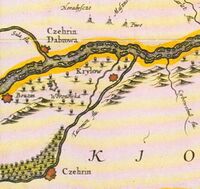
Chyhyryn is first mentioned as a fortified Cossack winter station. In 1638, Bohdan Khmelnytsky became its starosta (regional leader), and in 1648 it became the newly elected Hetman's residence and the capital of the Cossack state, the Zaporozhian Host. During the Russo-Turkish War (1676–1681) it was the center of two bloody campaigns (1675–76 and 1677–78). In 1678 the castle of Chyhyryn was blown up by the retreating Russian garrison that was stationed there, while the Turkish forces sacked the rest of the city. After this, it gradually lost its significance. The city fell under Ottoman occupation but was later recovered by the Cossacks while the Ottomans were busy in the Battle of Vienna. It remained the center of the Chyhyryn regiment until 1712. In 1790 the 8th Polish National Cavalry Brigade was stationed in Czehryń and in 1792 the 4th Polish Vanguard Regiment was stationed there.[2] It was annexed by the Russian Empire in the Second Partition of Poland (1793), and became part of the Kyiv region.
In 1917 a congress of Free Cossacks took place in Chyhyryn. At that congress by tradition Pavlo Skoropadsky was elected as the Hetman of the Cossacks (later in 1918 in Kyiv, he was elected the Hetman of Ukraine as well).
During World War II, Chyhyryn was occupied by the German Army from August 7, 1941 to December 12, 1943.
In 1989 the population of the city was 12,853.[3]
Until 18 July 2020, Chyhyryn served as an administrative center of Chyhyryn Raion. The raion was abolished in July 2020 as part of the administrative reform of Ukraine, which reduced the number of raions of Cherkasy Oblast to four. The area of Chyhyryn Raion was merged into Cherkasy Raion.[4][5]
Population
Language
Distribution of the population by native language according to the 2001 census:[6]
| Language | Percentage |
|---|---|
| Ukrainian | 93.14% |
| Russian | 5.37% |
| other/undecided | 1.49% |
Geography
Location
The city is on the banks of Tiasmyn River and lies at an altitude of 124 metres above mean sea level. Minor industries, such as food and furniture factories, are the basis of the town economy in the 21st century.
Climate
Script error: No such module "weather box".
Landmarks
The Trinity Monastery, built near Chyhyryn in 1627, was later destroyed by the Soviet authorities. Other historical landmarks, such as the town hall and Khmelnytsky's palace, did not survive either. After Ukraine regained independence, Hetman's residence was restored and became a museum.
Notable people
- Georgy Danilov, linguist
- Bohdan Khmelnytsky, hetman
- Kateryna Yushchenko, scientist
International relations
Twin towns — Sister cities
Chyhyryn is twinned with:
| City | Country | Year of Signing |
|---|---|---|
| Sebastopol, California | 1993 |
Gallery
-
Main square of Chyhyryn
-
Entrance of the restored Bohdan Khmelnytskyi residence
-
Bohdan Khmelnytskyi residence
-
St. Peter and St. Paul Church in Chyhyryn
-
A statue near the church
-
View of Chyhyryn from the city's Castle Hill
-
Remnants of Chyhyryn Fortress on the Castle Hill (reconstructed)
-
Bohdan Khmelnytskyi monument in Chyhyryn
See also
- Perevolochna, former fortress on Dnieper
References
- ↑ "Чигиринська територіальна громада" (in uk). decentralization.gov.ua. https://decentralization.gov.ua/newgromada/4864/composition.
- ↑ Gembarzewski, Bronisław (1925) (in pl). Rodowody pułków polskich i oddziałów równorzędnych od r. 1717 do r. 1831. Warszawa: Towarzystwo Wiedzy Wojskowej. pp. 10, 12.
- ↑ Всесоюзная перепись населения 1989 г. Численность городского населения союзных республик, их территориальных единиц, городских поселений и городских районов по полу
- ↑ "Про утворення та ліквідацію районів. Постанова Верховної Ради України № 807-ІХ." (in uk). 2020-07-18. http://www.golos.com.ua/article/333466.
- ↑ "Нові райони: карти + склад" (in Ukrainian). Міністерство розвитку громад та територій України. https://www.minregion.gov.ua/press/news/novi-rajony-karty-sklad/.
- ↑ https://socialdata.org.ua/projects/mova-2001/
- ↑ "World Meteorological Organization Climate Normals for 1981–2010". World Meteorological Organization. https://www.ncei.noaa.gov/pub/data/normals/WMO/1981-2010/RA-VI/Ukraine/12.6.%20WMO_Normals_Excel_Template%20(2).xls.
External links
 |

